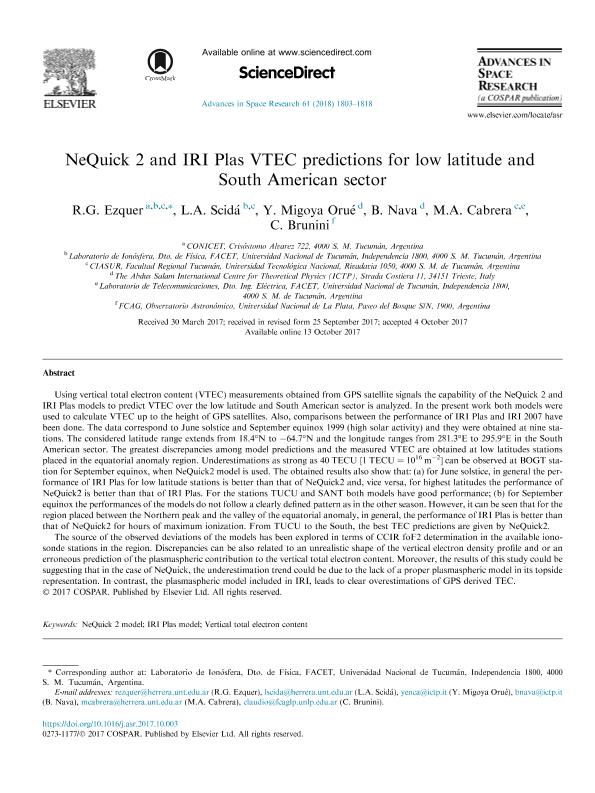Artículo
NeQuick 2 and IRI Plas VTEC predictions for low latitude and South American sector
Ezquer, Rodolfo Gerardo ; Scida, Luis Alberto; Migoya Orue, Yenca Olivia; Nava, B.; Cabrera, Miguel Angel; Brunini, Claudio Antonio
; Scida, Luis Alberto; Migoya Orue, Yenca Olivia; Nava, B.; Cabrera, Miguel Angel; Brunini, Claudio Antonio
 ; Scida, Luis Alberto; Migoya Orue, Yenca Olivia; Nava, B.; Cabrera, Miguel Angel; Brunini, Claudio Antonio
; Scida, Luis Alberto; Migoya Orue, Yenca Olivia; Nava, B.; Cabrera, Miguel Angel; Brunini, Claudio Antonio
Fecha de publicación:
04/2018
Editorial:
Elsevier
Revista:
Advances in Space Research
ISSN:
0273-1177
Idioma:
Inglés
Tipo de recurso:
Artículo publicado
Clasificación temática:
Resumen
Using vertical total electron content (VTEC) measurements obtained from GPS satellite signals the capability of the NeQuick 2 and IRI Plas models to predict VTEC over the low latitude and South American sector is analyzed. In the present work both models were used to calculate VTEC up to the height of GPS satellites. Also, comparisons between the performance of IRI Plas and IRI 2007 have been done. The data correspond to June solstice and September equinox 1999 (high solar activity) and they were obtained at nine stations. The considered latitude range extends from 18.4°N to −64.7°N and the longitude ranges from 281.3°E to 295.9°E in the South American sector. The greatest discrepancies among model predictions and the measured VTEC are obtained at low latitudes stations placed in the equatorial anomaly region. Underestimations as strong as 40 TECU [1 TECU = 1016 m−2] can be observed at BOGT station for September equinox, when NeQuick2 model is used. The obtained results also show that: (a) for June solstice, in general the performance of IRI Plas for low latitude stations is better than that of NeQuick2 and, vice versa, for highest latitudes the performance of NeQuick2 is better than that of IRI Plas. For the stations TUCU and SANT both models have good performance; (b) for September equinox the performances of the models do not follow a clearly defined pattern as in the other season. However, it can be seen that for the region placed between the Northern peak and the valley of the equatorial anomaly, in general, the performance of IRI Plas is better than that of NeQuick2 for hours of maximum ionization. From TUCU to the South, the best TEC predictions are given by NeQuick2. The source of the observed deviations of the models has been explored in terms of CCIR foF2 determination in the available ionosonde stations in the region. Discrepancies can be also related to an unrealistic shape of the vertical electron density profile and or an erroneous prediction of the plasmaspheric contribution to the vertical total electron content. Moreover, the results of this study could be suggesting that in the case of NeQuick, the underestimation trend could be due to the lack of a proper plasmaspheric model in its topside representation. In contrast, the plasmaspheric model included in IRI, leads to clear overestimations of GPS derived TEC.
Palabras clave:
Iri Plas Model
,
Nequick 2 Model
,
Vertical Total Electron Content
Archivos asociados
Licencia
Identificadores
Colecciones
Articulos(CCT - NOA SUR)
Articulos de CTRO.CIENTIFICO TECNOL.CONICET - NOA SUR
Articulos de CTRO.CIENTIFICO TECNOL.CONICET - NOA SUR
Citación
Ezquer, Rodolfo Gerardo; Scida, Luis Alberto; Migoya Orue, Yenca Olivia; Nava, B.; Cabrera, Miguel Angel; et al.; NeQuick 2 and IRI Plas VTEC predictions for low latitude and South American sector; Elsevier; Advances in Space Research; 61; 7; 4-2018; 1803-1818
Compartir
Altmétricas



